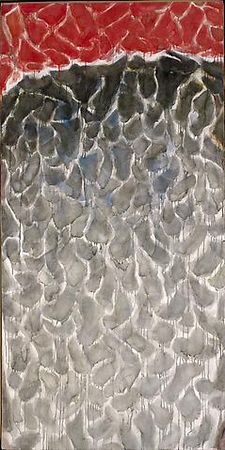“Masters of the Gesture” @ Gagosian Gallery
Clyfford Still, 1955-d, Ph-387, 1955. Oil on canvas, 117 1/2 x 111 inches (298.4 x 281.9 cm). Photo: Courtesy Gagosian Gallery.
BEVERLY HILLS, CA.- Gagosian Gallery presents “Masters of the Gesture”, an exhibition of major Abstract Expressionist paintings, drawings and sculptures, including works by John Chamberlain, Willem de Kooning, Sam Francis, Arshile Gorky, Adolph Gottlieb, Franz Kline, Lee Krasner, Joan Mitchell, Mark Rothko, David Smith and Clyfford Still. The exhibition includes loans from key private and public collections.
Works in the exhibition explore the range of direct, individualized gestures and dominating physicality that became the distinguishing characteristics of the Abstract Expressionist movement. Critically championed by Clement Greenberg, by the early 1950s Abstract Expressionist art was firmly established as the dominant movement in American art of the post-World War II era, marking the emergence as an equal counterpart in the U.S. to the new tendencies in modern European painting.
Influenced by their experiences during the interwar years that were marked by the detrimental effects of the Great Depression and World War II, the New York-based Abstract Expressionists viewed the world as emotionally barren and militated against political and social hegemony. This preoccupation with the human condition and the metaphysical became absorbed in their aim to build a new visual language, predicated on the immediacy of abstract forms, the monumental canvas, and the primacy of color. The many permutations of these principles can be seen in works including Arshile Gorky’s sensually colored Untitled (Last Painting) (1948) and Sam Francis’s meditative Red Over Gray (1953). From 1957, Adolph Gottlieb simplified his iconic pictographic canvas in later works to make way for the “bursts” in Antipodes (1959), where luminous circular forms levitate above gestural eruptions, evoking a primitive, even cataclysmic, view of life.
In the Abstract Expressionist syntax, the expansive canvas became a support for large swathes of color in varying scales and textures to achieve the sublime in art. The jagged edges and boundaries of striated verticals in Clyfford Still’s paintings appear to emerge from a richly dense background of color. The shifting red tones of 1955-d, Ph-387 (1955) reveal the many layers and hues that he used to create the illusion of depth in an essentially monochromatic work. The subdued yet complex tonal fields in Mark Rothko’s Untitled (Plum and Dark Brown) (1964) evoke a darkly spiritual meditation on color. In an effort to preclude associations with landscape, in 1968 he began experimenting with a white border to contain large areas of blacks in the uppermost region of the canvas, as in Untitled (Black on Grey) (1969-1970). In counterpoint to Rothko’s serene yet somber compositions, Willem de Kooning’s violent and chaotic brushstrokes, as typified by Untitled XXIV (1977), underscore a vibrant and unrivaled emotionality.
“Masters of the Gesture” coincides with “Abstract Expressionist New York” at The Museum of Modern Art, New York from October 3- April 25, 2011, and the announcement of the Clyfford Still Museum that is currently under construction in Denver, Colorado.
John Chamberlain, Dee Dee Bitch, 1976. Automobile metal relief, 51 x 37 x 19 inches (129.5 x 94 x 48.3 cm). Photo: Courtesy Gagosian Gallery.
Sam Francis, Red over Gray, 1953. Oil on canvas, 76 x 38 inches (193 x 96.5 cm).
David Smith, Voltri XVII, 1962. Steel, 95 x 31 1/2 x 30 3/4 inches (241.3 x 80 x 78.1 cm).

/https%3A%2F%2Fprofilepics.canalblog.com%2Fprofilepics%2F1%2F0%2F100183.jpg)
/https%3A%2F%2Fstorage.canalblog.com%2F03%2F02%2F119589%2F96711876_o.jpg)
/https%3A%2F%2Fstorage.canalblog.com%2F11%2F31%2F119589%2F94773502_o.jpg)
/https%3A%2F%2Fstorage.canalblog.com%2F20%2F83%2F119589%2F94772815_o.jpg)
/https%3A%2F%2Fstorage.canalblog.com%2F26%2F72%2F119589%2F75604929_o.jpg)
/https%3A%2F%2Fstorage.canalblog.com%2F59%2F60%2F119589%2F26458628_o.jpg)






/http%3A%2F%2Fstorage.canalblog.com%2F63%2F89%2F119589%2F129628544_o.jpg)
/http%3A%2F%2Fstorage.canalblog.com%2F49%2F98%2F119589%2F110043692_o.jpg)
/http%3A%2F%2Fstorage.canalblog.com%2F15%2F12%2F119589%2F96191999_o.jpg)
/http%3A%2F%2Fstorage.canalblog.com%2F92%2F23%2F119589%2F95023011_o.jpg)